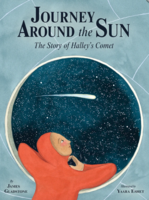"Our Shared Past and Future" James Gladstone's Halley's Comet Picture Book Offers Historical Perspective
Halley's Comet, possibly the most famous celestial event in existence, and one which happens just once every 75 years, is a unique phenomenon. It has been dazzling onlookers for centuries, and its story is now available in a kid-friendly format in James Gladstone's Journey Around the Sun: The Story of Halley's Comet (Owlkids, illustrated by Yaara Eshet).
A great way to introduce kids to the wonders of the natural world – and build a foundation for a life-long love of science –Journey Around the Sun is also a fun history primer. The picture book not only notes interesting facts about the comet, but also checks in with what was happening on earth each time the fabled comet appeared. Bringing science and culture together, Gladstone asks what the world might look like in 2061, when the comet is next predicted to return.
We're excited to welcome James to Open Book today to discuss Journey Around the Sun as part of our Kids Club interview series where we speak with writers for young readers. He tells us about being just 16 when the comet last appeared in 1986, why a picture book's short word count makes it a challenging but effective format, and why it's so tough to choose his favourite part of writing each of his books.
Open Book:
Tell us about your new book and how it came to be.
James Gladstone:
My new book is called Journey Around the Sun: The Story of Halley’s Comet. A few years ago I pitched a manuscript about a different comet to Owlkids. Karen Li, the editor at Owlkids at that time, asked if I would consider writing something about Halley’s Comet instead. I thought that was a great idea. I had watched the last return of Halley’s Comet in 1986 when I was 16. I even wrote a song about it at the time from the comet’s perspective. (No, I won’t sing it for you.) And that’s why I decided to let the comet narrate this children’s book.
OB:
Is there a message you hope kids might take away from reading your book?
JG:
The research for this book gave me a broader view of humanity's relationship with this relatively small object orbiting the Sun. I hope that kids might come to recognize that they are part of the continuity of human knowledge and understanding. Everyone alive now is a link between our shared past and future.
OB:
Did the book look the same in the end as your originally envisioned it when you started working, or did it change through the writing process?
JG:
The beginning and ending of the book mostly went as I originally thought. But the rest of the book was dictated by what I learned through research. I had fun with the writing, but I had to work with the facts.
OB:
What do you need in order to write – in terms of space, food, rituals, writing instruments?
Your CanLit News
Subscribe to Open Book’s newsletter to get local book events, literary content, writing tips, and more in your inbox
JG:
Perhaps three things are most important to me for writing: time, space, and quiet.
I need time to research and develop an idea and not rush it. And it’s best if I walk away from a piece for a few weeks and play around with it in my mind. The ideas often become more interesting when I stop trying to force something onto the page.
I need space to walk around in my apartment or outside. I do a lot of revision of ideas when I’m walking (with a phone or small writing pad at hand to record my thoughts).
A quiet space to work in helps when I’m doing the actual writing and revision on a computer or on paper. But quietness can be unpredictable while living in a building in Toronto, so I often write at night when the world has somewhat settled down.
OB:
Do you feel like there are any misconceptions about writing for young people? What do you wish people knew about what you do?
JG:
At times, I’ve heard people say that it must be easy to write a three- or four-hundred word picture book manuscript. Perhaps it is for some authors, but I’ve rarely found that to be the case. The fewer words I have to work with, the harder it seems to be. But I love the challenge of writing words around a visual story.
I once had an English professor who only ever assigned three-page essays. He said it’s more difficult to make a convincing argument in three pages rather than 20. After taking that class, I agreed with him. A picture book is not an essay, of course, but I think the point is relevant. It’s not as easy as it may seem to come up with a story idea and develop it into a short but meaningful manuscript—one that a publisher might want to turn into a book.
OB:
What's your favourite part of the life cycle of a book? The inspiration, writing the first draft, revision, the editorial relationship, promotion and discussing the book, or something else altogether? What's the toughest part?
JG:
Inspiration is near the top, for sure. But I get so many ideas that wind up going nowhere. So perhaps my truly favourite part is when I realize I have an idea that I think is going to work and I can get on with writing the first draft. But the revision process is also rewarding. That’s when I can shape all the weak spots into something that I’m excited to pitch to a publisher. And since I write picture books, there’s also the part when I first see rough drafts of the art. I really like that part. I suppose I have a few favourite parts. Sorry. That’s why I keep writing these books!
OB:
What are you working on now?
JG:
I’m working on a non-fiction book with Owlkids about a supernova first seen a thousand years ago.
_____________________________________________________
James Gladstone is an author of picture books for children, including When Planet Earth Was New, Earthrise, and Turtle Pond, which won the Norma Fleck Award for Canadian Children’s Non-Fiction. James’ latest book, Journey Around the Sun, follows Halley’s Comet on its travels through the ages. James lives in Toronto, Ontario.





